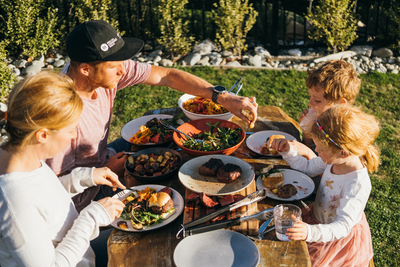Carb loading has to be one of the best things about being an athlete, right? When else in life are you advised to go and eat plenty of rice and pasta, all in the name of performance? In an added bonus, your carb load coincides with a time when the coach is instructing you to do less training and exercise.
Do less exercise, eat plenty of food — what's not to like about that? In reality, there's an art to nailing an eating strategy that leaves you feeling confident leading into a big event.
What is carb loading?
Carb loading refers to spending the last few days before a key event focusing our food intake on more carbohydrate-rich foods (such as potatoes, pasta, rice, and bread) in an effort to ‘super-compensate’ our glycogen stores. Glycogen is the form in which carbohydrates are stored within the liver and muscles, ready to fuel our race-day efforts.
During the final few days leading up to an event like an IRONMAN® or the Coast to Coast World Multisport Champs, my favourite dishes included:
- Oats or peanut butter and banana on toast for breakfast
- Rice, potato or pasta-based lunches and dinners, typically featuring white meat like chicken or fish and some vegetables
- To further boost my carbohydrate intake, I snacked on items like bananas, muesli bars, cereal, and toast with honey or jam throughout the day
- I also sipped on sports drinks to help top up my carbohydrate levels and ensure my electrolyte requirements were met

Quality over quantity
These dishes made sense given they were carbohydrate-rich and also lower in fat and fibre. It took me a few years to realise that carb loading isn’t about eating ‘more’ food, but instead it's eating normal amounts of food with a higher relative carbohydrate content.
So, we reduce fat to make room for carbs. Limiting fibre in the last couple of days before the race also helped put my mind at ease regarding the chances of experiencing gastric distress on race day. It was a lesson learned the hard way...
I remember the night before a Coast to Coast race many years ago. I went to a local pub for dinner and ordered lamb shanks with a side of carrots and broccoli. I enjoyed a hearty feast of epic meat proportions and went to bed with a satisfyingly full tummy.
Unfortunately, during the mountain run stage the next day, I had stomach pains, bloating, and an inability to digest as much fuel as normal. It didn’t take long for my coach and I to blame the fatty and fibrous nature of my pre-race dinner for the tummy issues that ensued.
The mental challenges
Carb loading comes at a time when energy expenditure through exercise is becoming less and less as training tapers off into race day. This helps support the saturation of glycogen in the body as less is being used, but it can also lead to some interesting mind games.
If someone wants to gain weight, they’ll generally achieve it if they exercise less but keep the same amount of food going in. I found it was very common (well, guaranteed actually) during the taper and carb loading phase to see the scales start to tip upwards by a kilogram or two.
Given bodyweight affects performance in sports that reward power-to-weight ratio (such as running and cycling), I always found it tricky to mentally accept my increasing weight as race day looms.
I remember going to one IRONMAN® registration and submitting an official pre-race weigh-in that felt embarrassing to admit to. But what I came to understand and appreciate better was how important the ‘weight’ in my body was.
We’d never start a long road trip in a car with an empty tank of gas, nor should we expect to draw much from ourselves physically on race day if we haven’t topped up our energy. Those extra kilograms showing on the scales before race day captured the extra fuel I had in the tank which would serve me well once the starter gun went off.
Pre-race fueling
The ‘icing on the cake’ when it came to my pre-race carb loading was the energy gel I’d consume about 15 minutes prior to the start. Generally, by this stage, I would be finishing my warm-up, which likely would’ve taxed a little bit of my glycogen stores. I found it a psychological boost to take an extra 30-gram carbohydrate hit and know my stored energy was back at its maximum as we rolled into 'go-time'.
Fifteen minutes prior seemed long enough for me to feel it would digest okay as I sent my body into battle. Of course, the next challenge was meeting my carbohydrate and hydration demands for the entirety of the race duration. But if I nailed my carb loading in the days leading up, at least I knew I was getting off to the best possible start.
